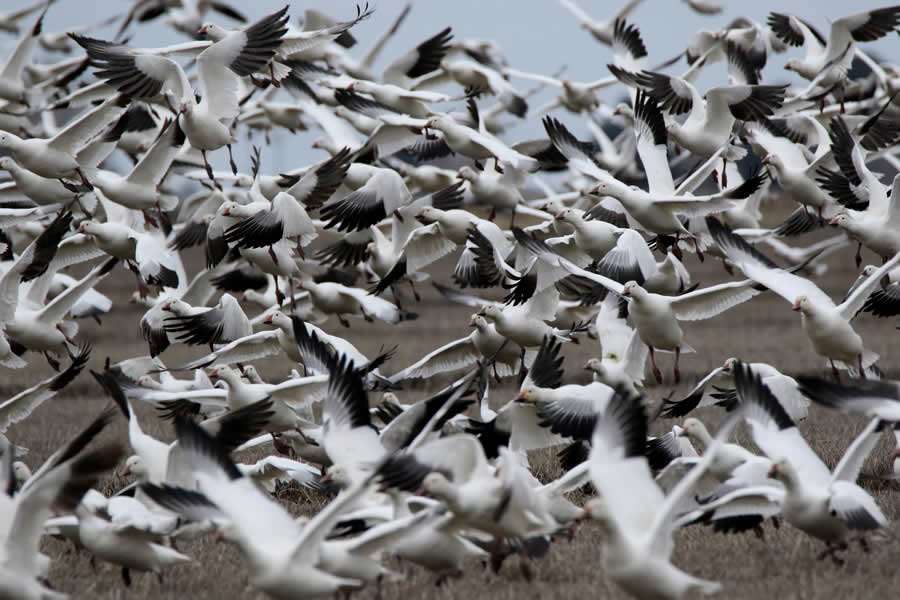Early one morning about 12 years ago or so, I was awakened by a flock of low flying geese taking their flight path right over my house. Nothing out of the ordinary actually as I live in farm country, and geese are an everyday occurrence for me.
But there was something very peculiar about these particular geese, something so strange but yet still familiar about the way they sounded.
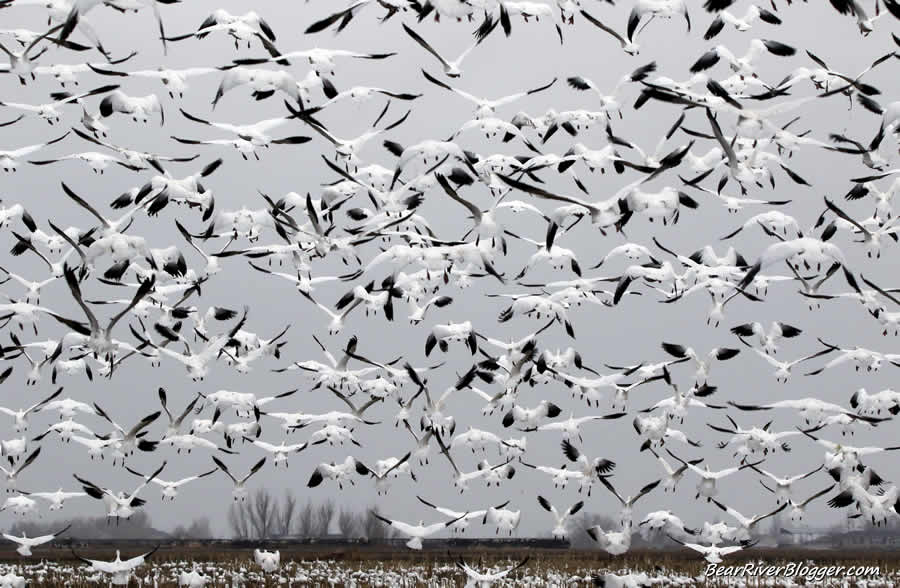
As an avid birder, I immediately got up to investigate and even rushed outside before I took any thought to where my shoes and socks were. Much to my astonishment, it was a large flock of snow geese, possibly two hundred or more, barely clearing the large elm trees in my yard as they intently headed northward.
They were flying very low and a bit erratic over the empty fields which dot the landscape around my house, but I could tell the geese had a destination in mind, and I had to find out where it was.
Jumping into my car, I followed the geese for a couple of miles, where they circled for a bit and then promptly landed in a harvested cornfield left from last year. I was shocked, literally flabbergasted, to say the least.
The field was almost completely white as thousands of snow geese had already landed and were actively feeding on the leftover grain.
This was news to me as I had never seen a snow goose in Utah before. I actually had no idea snow geese migrated through Utah except for the occasional wayward bird or two during fall migration.
I learned something that day. Yes, I learned something wonderful on that warm, sunny mid-March morning and each day thereafter for several weeks as I rose early each morning to follow the geese as they flew past my house to a nearby field to feed. I learned that snow geese, thousands of snow geese, in fact, do indeed migrate through Utah.
It was a much-welcomed surprise to learn about the migrating snow geese coming through Utah, literally in my own backyard in a sense, and I have enjoyed and looked forward to seeing them each and every year since then.
This year has been no exception, and I am happy to report the first small flock of snow geese flew over my house a couple days ago on February 2.
Where can I see snow geese in Utah?
It is actually well-documented thousands of snow geese migrate through Utah each spring. They typically have a couple major stopping points where they feed and rest for a few weeks before returning to their 3,000-mile flight northward to the arctic tundra to breed.
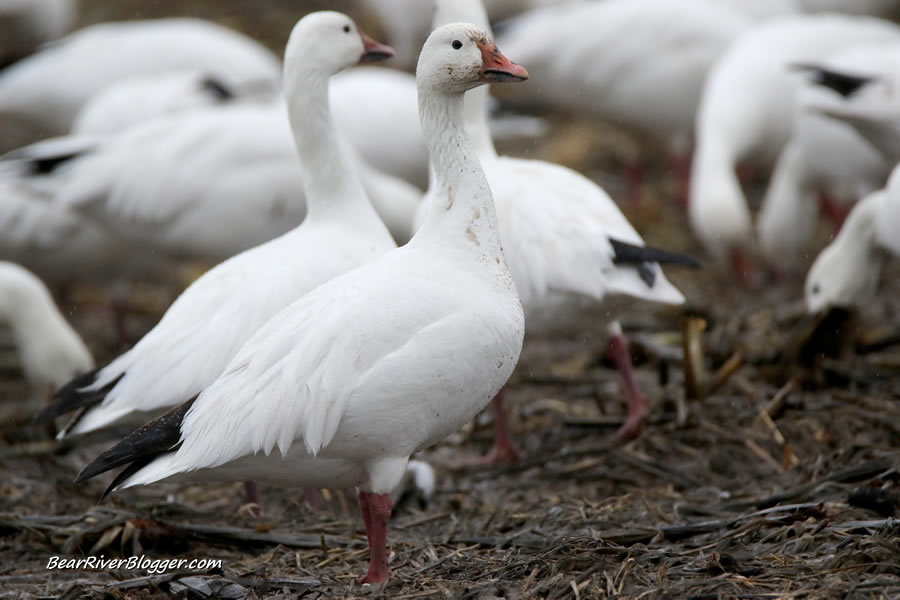
The most well-known spot is near Delta, Utah. There the geese spend the day on Gunnison Bend reservoir and feed on nearby grain fields. This spot has become so well known the local community operates a yearly snow goose festival each February in the small town of Delta to celebrate the annual pilgrimage of nearly 20,000 snow geese visiting their town for a few short weeks.
But that isn’t the only place we bird watchers can view and photograph snow geese as they migrate through Utah. A lesser-known spot, but one much closer to residents of northern Utah, is a rural farming community near the Bear River Migratory Bird Refuge in Box Elder county, about an hour north of Salt Lake City.
After the snow geese leave Delta, their next major resting place is in and around the small towns of Bear River City and Corinne. The geese spend their days roosting on a large shallow lake on the Bear River Club and feed in the nearby grain fields in Corinne and Bear River City.
What time of the year can I see snow geese in Utah?
Snow geese can be seen in Utah during both spring and fall migrations, but it is uncommon, even a bit rare in fact, to see them during fall migration. From what other people have told me, the geese might be taking a more westerly route during fall migration, so very few of them actually come through Utah.
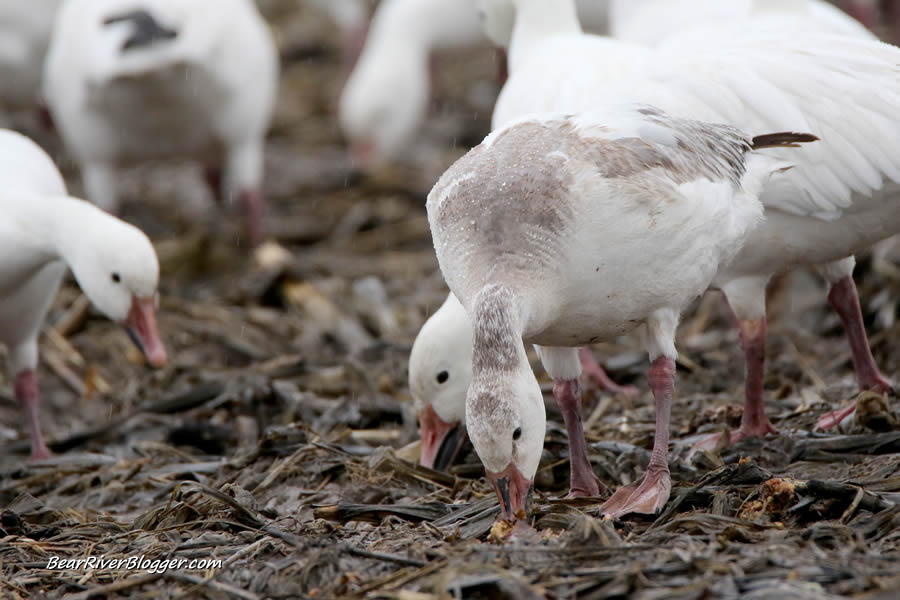
Spring migration is hands down the best time of year to see the mass migration of snow geese as they come through Utah. Typically mid-February is when the birds are at their peak in Delta, and mid-March is when they are in great numbers in Box Elder County.
Here in Box Elder County, I typically start seeing small flocks of snow geese around the early to middle parts of February, especially during years when we have winters a bit warmer than usual.
As noted earlier, I have already seen a small flock of a dozen birds three days ago, so the geese are already starting to show up in small numbers, but the month of March is when the extraordinary sized flocks show up and the best time to observe and photograph them.
One thing to consider for those wanting to come view and especially photograph the snow geese in both Delta and Box Elder Counties, in recent years the Utah Division of Wildlife Resources has opened up a spring hunt for snow geese, and while the hunt is open, the geese are a bit erratic and harder to observe and photograph.
This year the hunt ends on March 10, and once the birds settle down for a few days or so, they are much easier to find, observe, and photograph. I have literally seen them just a few yards away from the roads, as you can see in some of my photographs, but until the hunt ends, it isn’t common for them to be so close to the road and so easily observed and photographed.
What time of day is best to watch the snow geese?
Snow geese are an interesting bird, to say the least. They are a bird most accurately categorized by being a creature of habit. The best times for watching snow geese will depend on which location you prefer to visit.
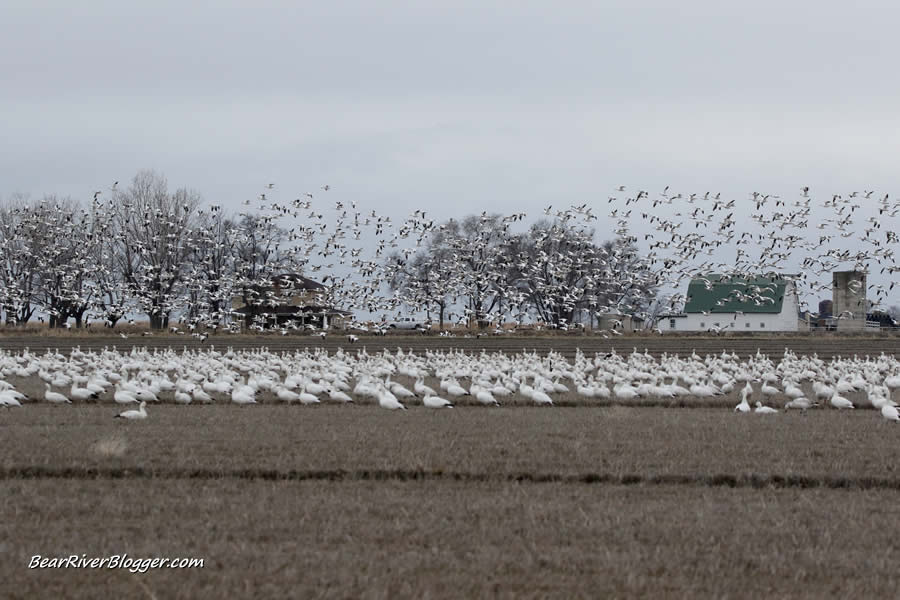
The geese in Delta are easily seen on both Gunnison Bend reservoir and in the nearby fields. The snow geese in Box Elder County are a bit more secluded and are not publicly visible on the water, but they are very easily seen in the grain fields.
The birds roost on the water during the day and feed both early morning and late evening in the nearby farm fields. This is pretty much a very regular and predictable routine for snow geese as they migrate through Utah.
I have been to the snow goose festival in Delta and have seen the birds roosting in one large flock on Gunnison Bend reservoir during the day. It is quite a sight to behold for sure. It is also quite the spectacle to see the thousands of birds start to lift off and head out in large flocks to find waste grain to feed upon.
This happens both early morning and late evening in both Delta and Box Elder County. If you are in Delta, you can see them just about any time of day, depending on if they are out feeding in a field or roosting on the reservoir.
Finding them feeding in the fields isn’t always easy, so if you want to see them in the fields it is best to get there early in the morning or early in the afternoon so you can follow them out to feed. If you are there during the middle of the day, you can almost always see them roosting on the reservoir when not out feeding.
In Box Elder County, as in Delta, the birds also feed twice per day. They are usually heading out to the fields just as the sun is coming up and over the Wasatch Mountains, and they are again back out in the fields in the early afternoon.
It is almost like clockwork. So even though their roost is out of reach to the public their feeding habits, being as predictable as they are, make them easy to find for both their morning and evening flights to the nearby fields. The easiest way to find them is to park along 2400 North in Corinne and watch westward for the geese to come off their roost and head east to feed in the farm fields.
Are there snow geese on the Bear River Migratory Bird Refuge?
Strange as it might sound, the snow geese do not utilize the Bear River Bird Refuge during spring migration, even though the 77,000-acre preserve is only a couple miles away from where the geese roost and feed.

I am not sure why but the snow geese sit on a nearby marsh during the day. The Bear River Club, a private waterfowl hunting club, is the preferred spot for the migrating snow geese when they arrive in Box Elder County. It sits adjacent to the refuge, but its location is far from the public view so, unfortunately, the geese can only be seen in flight and out feeding in the nearby grain fields.
The snow geese are quite an extraordinary sight to behold, both in Delta and in Box Elder County. If you are interested in seeing the snow geese this year, subscribe to my blog and follow us on Facebook.
I will be following and photographing them as they arrive in bigger numbers here in Box Elder County and will let you know when I start seeing them in large flocks, so be sure to go to our subscribe page and sign up for blog post notifications for future posts.

